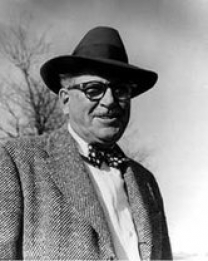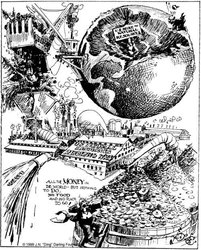Darling, Jay Norwood "Ding"
Darling, Jay Norwood "Ding"
Jay Darling was born in Norwood, Michigan, and spent most of his boyhood on the edge of the American frontier in Sioux City, Iowa. Childhood days were spent exploring the expansive prairies of Nebraska and South Dakota and the banks of the Missouri River where his lifelong devotion to conservation began. As soon as he was old enough, Darling hired himself out to herd cattle across the South Dakota plains.
College began badly for Darling when he and some friends "borrowed" the president's horse and buggy for an evening of revelry. He was dismissed from Yankton College in South Dakota in 1894 and began again at Beloit College in Wisconsin the following year. Darling planned to study medicine, the natural outgrowth of his interest in biological systems. Although he applied himself in the life sciences, his major focus at Beloit became his job as art editor for the college yearbook. Darling's irreverent cartoons of Beloit's faculty earned him another suspension, but he returned for his senior year and graduated in 1900. In spite of his escapades, Darling was forever influenced by his biology professor who taught him to view the world as a complete system and always frame it in ecological terms.
Darling accepted a job with the Sioux City Journal in order to save money to enter medical school. It was there, however, that his career as a political cartoonist blossomed, beginning with a story he ran accompanied by a sketch of the story's character—a local recalcitrant attorney who refused to have his photograph taken for the piece.
Darling took the pen name "Ding" to accompany his cartoons and by 1917 was syndicated across the country through the New York Herald Tribune. Eventually Darling's political cartoons would appear in 130 daily newspapers. His first conservation cartoon was published during Teddy Roosevelt's first term as president in 1901 in support of Roosevelt's campaign for establishment of a forestry service, a policy first suggested 25 years earlier by the reformer (and Secretary of the Interior) Carl Schurz. Roosevelt found an ally in Darling for the cause of conservation and the two became great friends. Darling authored two books and twice won the Pulitzer Prize for cartooning, in 1923 and again in 1942. He used his satirical pen to promote issues of conservation and to bring national attention to environmental concerns. Most important to Darling were issues of wildlife exploitation and the destruction of irreplaceable waterfowl habitat.
Although a staunch Republican, Darling was nevertheless recruited in 1934 by President Franklin D. Roosevelt to serve on the President's Committee for Wild Life Restoration along with two other prominent individuals, Aldo Leopold and Thomas Beck. The "Beck" or "Duck" Committee, as it came to be called, assumed the task of preparing a plan to direct funds into a new wildlife program to replace the Bureau of Biological Survey. Darling and Leopold, however, believed the work could be accomplished within the Survey as long as the proper funding was forthcoming. As validation for his work on the committee, Darling was offered the job as head of the Biological Survey in 1935, and he agreed to accept it on a temporary basis. As Director, Darling was often called the "best friend a duck ever had." His tenure as director was only 18 months, but in that time Darling was instrumental in injecting new energy into the Survey. Under his guidance, the Duck Stamp Act of 1934 was developed and Darling himself designed the first stamp.
With help from a group of industrialists who provided the funds, Darling organized the various sportsmen groups of North America into the National Wildlife Federation and promoted the annual observance of National Wildlife Week. He hoped to use the Federation as a conservation organization which would bring together concerned citizens across the nation. The world-famous wildlife conservation stamps were devised and produced by the Federation. Darling was also able to obtain agreement from every arms and ammunition supplier in the country to contribute ten percent of their gross receipts to federal conservation programs. He was most satisfied, however, with his successful efforts to restore the very near disappearance of Nevada's Sheldon Antelope Refuge which had become the "most desolate piece of the American continent [he] ever visited." Another important part of the Darling legacy at the Survey was his appointment of a young J. Clark Salyer II as head of the national wildlife system which grew to 279 national wildlife refuges encompassing 29 million acres by the time Salyer left his post in 1961.
Darling was also one of the founders, and then first President of the National Wildlife Federation in 1938. He later criticized the organization, and the proliferation of conservation organizations in general, because he first envisioned the Federation as an umbrella for conservation efforts and thought the emergence of too many groups diluted the focus on solving conservation and environmental problems. Until the end of his life, he tried, and failed, to organize a conservation clearing house that would refocus the conservation effort under one heading.
Upon his resignation in 1935, the reins of a new and reinvigorated Survey were passed to Dr. Ira Gabrielson who remained at its head for more than a decade. Darling returned to drawing cartoons and influencing conservation policy through his political statements and his work with the Wildlife Federation. After his death in 1962, the J.N. "Ding" Darling Foundation was organized to carry on his work, and in 1965, the J.N. "Ding" Darling National Wildlife Refuge on Sanibel Island, Florida, one of Ding's favorite bird-watching locations, was set aside in his honor.
Further reading
Dudley, Joseph P. Jay Norwood 'Ding' Darling: A Retrospective. Conservation Biology 7, no. 1 (March 1993): 200–203.
Jay N. Darling: More Than a Cartoonist. The World of Comic Art 1, no. 1 (June 1966): 18–25.
Lendt, David L. Ding: The Life of Jay Norwood Darling. Ames, IA: Iowa State University Press, 1979.
JN "Ding" Darling National Wildlife Refuge
| Disclaimer: This article is taken wholly from, or contains information that was originally published by, the U.S. Fish and Wildlife Service. Topic editors and authors for the Encyclopedia of Earth may have edited its content or added new information. The use of information from the U.S. Fish and Wildlife Service should not be construed as support for or endorsement by that organization for any new information added by EoE personnel, or for any editing of the original content. |


0 Comments